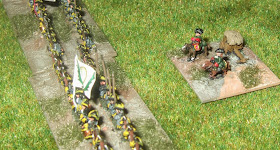Zheltarus was one of the smaller Grand Duchies that cluttered the map of eighteenth century eastern Europe. Its thin, rocky soil produced little (mostly turnips) for the merchants of neighbouring empires and kingdoms to covet. Likewise the Grand Ducal family’s crop of princesses (who tended to the porcine) rarely excited the marriage market of the Balkan courts.
That said, the Grand Duchy was at least reasonably peaceful, being halfway between nowhere in particular and nowhere else. Campaigning foreign armies rarely found the need to struggle up its rock-strewn hillsides or to cross its rickety bridges.
All this changed, however, with the arrival of Murad the Vicious. This notional vassal of the Ottoman Sultan intrigued and murdered his way to power in nearby Yesilkara. Having settled himself on the Emir’s gilded divan, he turned his rapacious gaze upon the weakest of his neighbours.
The Grand Duke at this time was Mikhail III. His predecessor, also a Mikhail, had been renowned as an intellectual who owned several books and was known to have read at least one of them. He had also introduced the staircase to Zheltarus.
The third Mikhail continued his father’s modernising by turning his attention to the army, reorganising the traditional, politically troublesome, district militia into infantry regiments in the Western European style. By 1715 bayonets and tricorn hats had largely replaced berdische axes and fur-lined caps as the infantry embraced modern, linear tactics.
The cavalry was more of a challenge with much of the senior arm being made up of tribal horse recruited under ancient treaty from the Cossacks of the Slavitsa basin. Nevertheless Mikhail did manage to create a handful of regiments of native Zheltarussian dragoons.
The Grand Duke’s particular pride, though, was the artillery. Employing foreign specialists he built up an impressive arsenal. He also created what may have been Eastern Europe’s first modern artillery train. Unlike the wagon masters of the earlier Zimbielo dynasty, these professionals were expected to move their guns even on saints’ days and could generally be relied upon to remain in the same district as them after battle had been joined.
If I decide to go with this I'll have to come back later to cover Yesilkara.

I'm looking forward to seeing how your Russians pan out, as that is one of the armies I have (I unimaginatively call them 'Russians' though). And I'm certainly looking forward to seeing a Maurice Turkish army in action.
ReplyDeleteI assume both armies will be Post-Pike?
ReplyDeleteSomeone told me that the Russian army that faced the Turks on the Pruth in 1710 had left its pikes behind.
ReplyDeleteI’ll probably go post-pike for simplicity (not having to remember the modifiers) but it would be interesting to try them once.
The advantage of the imagi-nation route being that I can try these things out whenever I like.